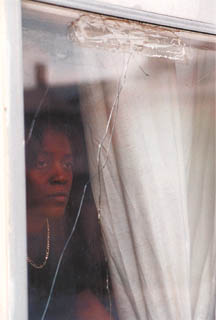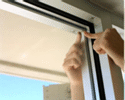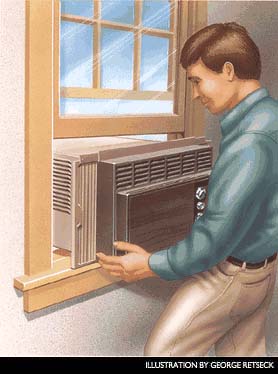 Caulk frames and openings. Air infiltration can occur around the frames of doors, windows and skylights, resulting in heat loss in the winter and heat gain in the summer. Caulking these areas can save on heating/cooling costs and increase resident comfort. Existing caulking that is cracked or deteriorating should be scraped out and replaced with new caulk.
Caulk frames and openings. Air infiltration can occur around the frames of doors, windows and skylights, resulting in heat loss in the winter and heat gain in the summer. Caulking these areas can save on heating/cooling costs and increase resident comfort. Existing caulking that is cracked or deteriorating should be scraped out and replaced with new caulk.
- Patch holes in the building envelope. Holes in the walls, roof, foundations, doors, and vestibules allow air infiltration, resulting in heat loss in the winter and heat gain in the summer. These holes should be patched to save on heating/cooling costs and to increase resident comfort. Qualified personnel should repair holes in accordance with building construction type.

- Repair cracked windowpanes. Broken windowpanes allow air infiltration, resulting in heat loss in the winter and heat gain in the summer. Repairing them will save on heating/cooling costs and increase resident comfort. Broken panes should be repaired only as a temporary measure before the window can be replaced.
- Weather-strip windows and doors. Weather-stripping reduces infiltration around windows and doors, particularly if storm windows and doors are not present. By helping to keep warm air inside during the winter and cool air inside during the summer, weather-stripping saves energy and increases resident comfort. Flexible rubber or plastic strips can be installed to seal any gap between the edge of an operable window and its sash. In general, weather-stripping should not be installed on windows or doors that will be replaced soon.

- Install storm windows and doors at the beginning of the heating season. In developments that have storm windows and storm doors, maintenance staff should make sure that the proper panels are in place at the beginning of the heating season.
- Remove unit air conditioners in the winter. At the start of winter, air conditioners should be removed to reduce infiltration. If removal is not possible or practical, the air conditioners should be covered with special sleeves.

- Open and close shades in common areas. In the winter, blinds or curtains in common areas such as community rooms, lobbies, and offices should be closed at night to keep warm air inside, and open on sunny days to let the sun's rays help heat the room. In the summer, they should be closed during the day to minimize heat gain.
- Lower awnings in the summer. In developments that have awnings, maintenance staff should make sure they are lowered in the summertime to reduce heat.
- Check automatic door closing mechanisms. Automatic door closers on exterior doors should be adjusted so that doors close quickly and completely.
For more ways to reduce energy costs, see PHECC's Energy COnservation Measures.
|
TURN OFF UTILITIES: Turn off electricity, gas, propane, and other utilities before starting repairs, cleaning, or installations to avoid accident or injury. BE AWARE OF LEAD-BASED PAINT HAZARDS: Many residences built before 1978 have paint that contains lead, which can pose a serious health hazard if paint, chips, and dust are not handled properly. See the U.S. Environmental Protection Agency (EPA) lead brief before disturbing painted surfaces in homes of this vintage. Follow the HUD "Lead-Safe Housing Rule" for requirements for notification, evaluation and reduction of lead-based paint hazards. BE AWARE OF ASBESTOS HAZARDS: Homes older than 1977 may have building products that contain asbestos such as insulation, high-temperature gaskets, roofing and siding shingles, and vinyl sheet flooring. See the EPA asbestos brief before disturbing such materials. BE AWARE OF MOLD AND MOISTURE HAZARDS: Molds can gradually destroy materials they grow on; can irritate the eyes, skin, nose, throat, and lungs of both mold-allergic and non-allergic people; can cause asthma attacks in people with asthma who are allergic to mold; and can cause other serious health problems. To learn more about preventing and cleaning up mold in homes, see these mold guides and the EPA brief on What to Wear When Cleaning Moldy Areas. |
- Log in to post comments